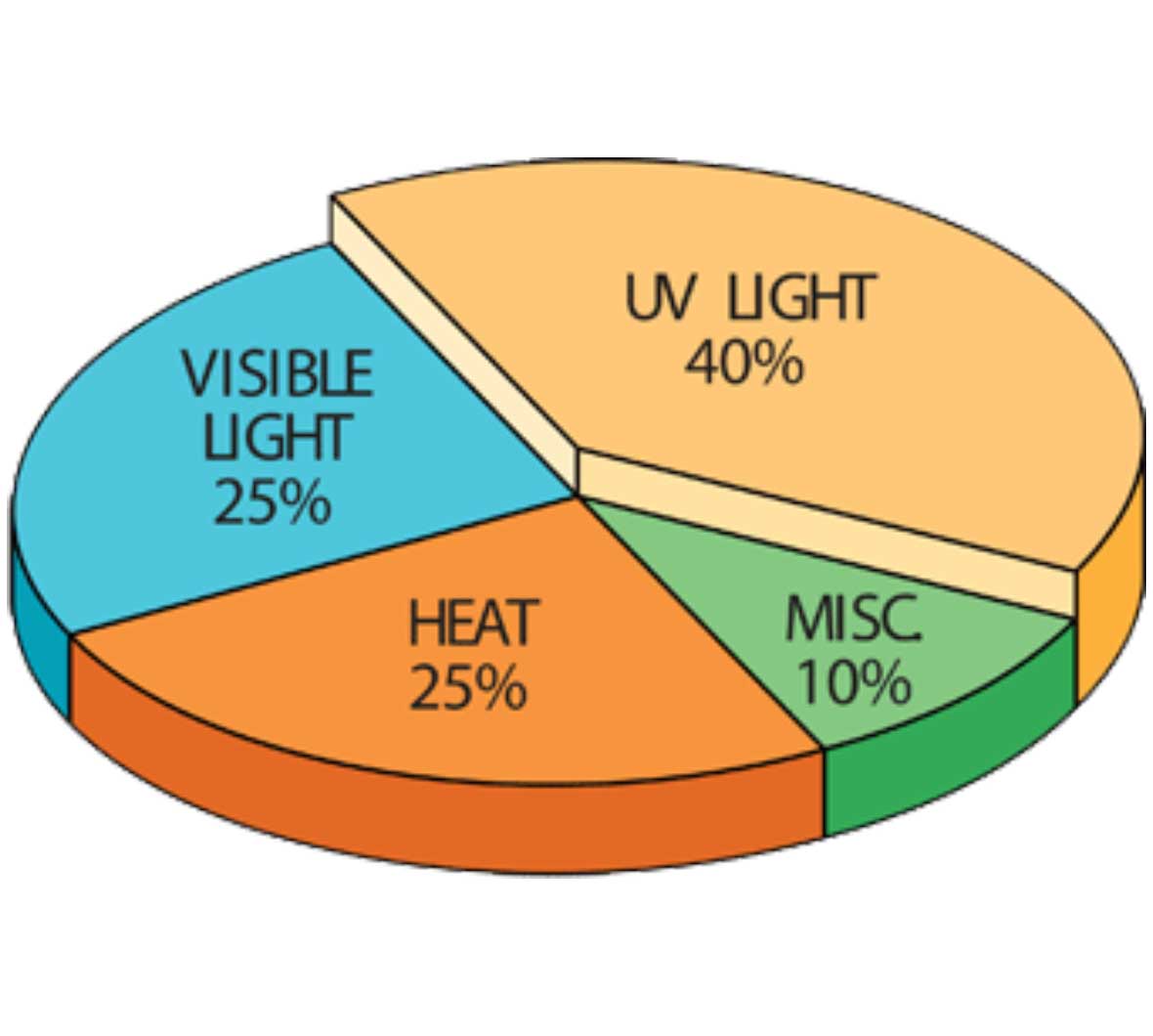Looking for FILM PROTECTION FOR YOUR WINDOWS?
READ MORE
Ply is used to display the number of separate layers of polyester film that are used in the manufacturing process to make a particular window film product. Example: A 1-ply product would consist of one single layer of polyester film where a 3-ply product would be made with three separate layers of various types of polyester film.
Mil is the unit of measurement equal to one thousandth of an inch (.001”). Mil thickness is used in the GWF nomenclature to display the overall thickness of the window film product. 1 MIL = 25 micron
Solar energy transmitted is the ratio of the total solar energy passing through the glazing system to the amount of total solar energy falling on that glazing system.
Solar energy absorbed is the ratio of the amount of total solar energy directly absorbed by the glazing system to the amount of total solar energy falling on that glazing system.
Solar energy reflected is the ratio of the amount of the total solar energy directly reflected by the glazing system to the amount of total solar energy falling on that glazing system.
Visible light transmitted is the ratio of visible solar energy (380 – 750nm) that passes through the glazing system to the total visible solar energy falling on the glazing system.
Visible light rejected is the total percentage of visible light reflected by a glazing system that can be seen visually. GWF performance results includes Interior and exterior VLR specifications on all films.
Near Infra Red Blocking
Ultraviolet rejected is the ratio of ultraviolet solar energy (wavelength of 300 – 380nm) that is transmitted by a glazing system to the total solar ultraviolet energy falling on the glazing system. Note: UV energy is not visible to human eye and is mainly responsible for the degradation and fading of organic matter, upholstery, colors, etc.
Shading coefficient is the ratio of the solar heat gain through a given glazing system to the solar heat gain under the same conditions for clear, unshaded double strength window glass. The lower the shading coefficient number, the better the sun control capability of the glazing system.
Solar heat reduction, is the reduction in solar energy gained by a building from the sun, often by the addition of solar control window film.
Total solar energy rejected is the percentage of incident solar energy rejected by a glazing system which is equal to solar reflectance plus the part of solar absorption which is re-radiated outward.
Glare reduction is the percentage of reduction in visible light transmission through a glazing system without film to that with film.
Emissivity is a measure of surface’s ability to absorb or reflect far-infrared radiation. The lower the emissivity the higher the far-infrared reflection. Infrared radiation is that which is sensed by the body as heat. The lower the emissivity rating, the better the insulating qualities of the glazing system.
U-value is a measure of the rate of heat conductivity of a glazing system, independent of solar radiation. When multiplied by the difference between indoor and outdoor temperature in Fahrenheit, it gives the amount of heat in BTUs/hours/square foot of glazing. Note: the greater the difference between indoor and outdoor temperatures, the greater the U-value, so it is important to use the U-values closely representing your conditions. The lower the U-value the better the insulation qualities of the glazing system.

It is generally accepted that ultraviolet (UV) radiation is responsible for roughly 40 percent to as much as 60 percent of all *fading. In addition to UV other factors that can cause fading include:
* Although Global window films block out almost 100% of harmful and damaging ultraviolet, it is important to understand that no window film can totally prevent or stop fading.
| Product Series | GHP CH 20 PS |
| Product Series | GHP CH 20 PS |
| Product Series | GHP CH 20 PS |
| Product Series | GHP CH 20 PS |
| GHP | Global High Performance |
| GNR | Global Non Reflective |
| GES | Global Estate |
| GSG | Global SunGate |
| GRF | Global Reflective |
| GSF | Global Specialty |
| BK | Black |
| BKO | Black Out |
| BL | Blue |
| BR | Bronze |
| SB | Solar Bronze |
| CH | Charcoal |
| CL | Clear |
| GP | Graphite |
| GR | Grey |
| MT | Matte |
| NE | Neutral |
| NICR | Nichrome |
| NI | Nickel |
| QD | Quick Dry |
| QDP | Quick Dry Plus |
| RD | Red |
| SV | Silver |
| WH | White |
| WHO | White Out |
| YW | Yellow |
| PS | Pressure Sensitive Adhesive |
| UCD | Ultra Clear Dry Adhesive |
| A | Absorbed |
| CW | Clear Weatherable |
| DR | Dual Reflective |
| E | Emissivity |
| GR | Glare Reduction |
| IR | Infra Red |
| NF | Nano Film |
| NIRB | Near Infra Red Blocking @ 1025 NM |
| R | Reflected |
| SC | Shading Coefficient |
| SRC | Scratch Resistant Coating |
| SHR | Solar Heat Reduction |
| T | Transmitted |
| TSER | Total Solar Energy Rejected |
| UVR | Ultraviolet Rejected |
| VLT | Visible Light Transmitted |
Be the first to know all exciting news & information about Global Paint Protection Film.